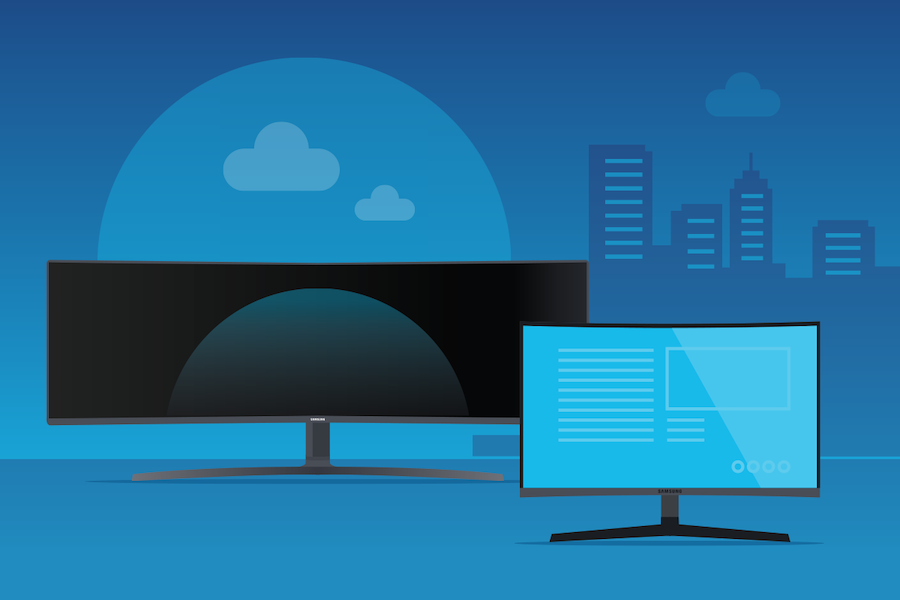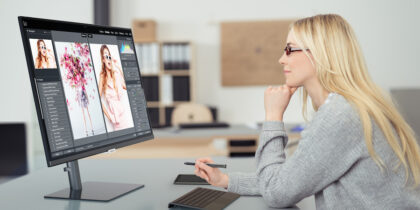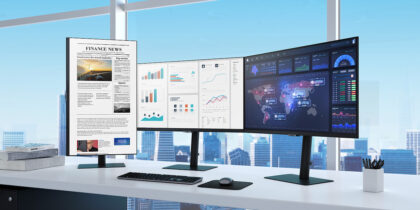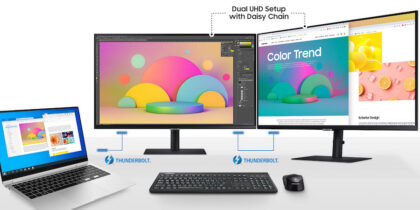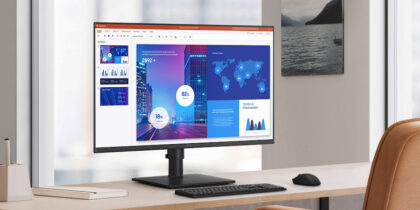Creating a productive workspace begins with the desktop monitor you choose. A bigger monitor with greater visual clarity and depth, for example, can keep programmers, designers and healthcare professionals focused on their work, not on logistical distractions. With the right technology for their workspaces, people can work more efficiently and comfortably.
Here are some considerations for creating a modern, productive workspace with the right monitor for your employees.
Increased productivity and efficiency
Widescreen monitors allow employees to simultaneously work with multiple apps on one desktop. This type of monitor can help several types of professionals — from financial staff to graphic designers to programmers — who can use the added screen real estate to boost productivity and create more efficient workspaces. This can allow programmers to open multiple development tools side by side, while artists can move seamlessly from composition to layout.
Which monitor is best for your workstation?
Get personalized recommendations on the optimal monitor setup for your space. Download Now
What’s more, selecting the right type of screen in terms of size and aspect ratio can help employees’ morale and eye health. Because different displays offer varying aspect ratios, brightness levels and response rates, as well as features such as Flicker Free technology and Eye Saver Mode, selecting a monitor isn’t necessarily a one-size-fits-all operation. Knowing how to tailor these characteristics to accommodate specific jobs can help reduce eye strain and improve ergonomics.
Enhanced displays’ longer life cycle is also a benefit from a cost perspective. They might demand a bit more upfront capital, but you won’t be swapping out monitors as often, thus saving money in the long run.
An immersive experience
Curved monitors give users a broader, more natural range of view, maintaining clarity and color depth for a larger area. The human field of view naturally arcs along a curve, so this monitor format displays images with minimal distortion and maximum clarity, no matter where they are on the screen.
The size of the canvas matters, too: A 49-inch ultra-wide curved monitor creates the visual real estate equivalent of a pair of 27-inch monitors running side by side — an effective increase from a 22:9 aspect ratio to 32:9. These monitors offer a more immersive and ergonomic experience that lends itself to several use cases, from media editing to viewing spreadsheets.
The in-plane switching (IPS) panel technology in Samsung’s S Series of monitors offers crystal-clear images and text and a 178-degree viewing scope, allowing views to position the screen wherever it fits best and still see everything. This wide visibility also enables group viewing.
Executives in some industries are fond of these immersive monitors because they can view comprehensive data while doing their daily work. The large viewing screen not only lets users zoom in on fine details, it also increases the peripheral view, enhancing overall visibility. These capabilities make curved and widescreen monitors ideal for those handling multiple complex workstreams, high-definition images and video or intensive animation and rendering projects.
Benefits of streamlined connectivity
As displays evolve to include more integrated connections — and technologies like Samsung DeX emerge on the market — employees can create an almost cable-free desk that ties into a seamless workflow. USB-C and Thunderbolt give users access to faster and more secure data transfer speeds.
For employees who spend time away from their desk, the DeX docking station can also expedite data transfer and centralize document access. By connecting a Galaxy smartphone or tablet to a mouse, keyboard and monitor, DeX lets users create a desktop-like experience that can reduce the need for extra wires and paper, reducing clutter and enhancing the workspace.
Samsung’s Webcam Monitor includes a built-in camera and speakers, which cuts down on the cords and connections workers need, and the headaches that can come from connecting multiple devices. This feature is especially important for workers who regularly participate in virtual meetings.
Monitors in the contemporary workplace
When planning your hardware budget, take a step back and focus on your standard computer monitor and compare it to the current monitor market. Creating a productive workspace starts by deploying a high-performance monitor that meets your business and technology needs.
Before a single purchase is made, it’s important to understand the precise needs of each team, any special accommodations necessary (for the workspace or the individual) and the capabilities and requirements of available hardware and software. Buying too small a monitor will hamper performance, while buying large-format displays without the appropriate graphical hardware may hinder performance. Armed with the right information, you can choose the right displays for you and your team and optimize efficiency and satisfaction.
Monitors are more than just displays. Learn more about how USB-C, HDMI and Thunderbolt 3 enable complete workstations in this free, comprehensive guide. If you’re not sure which monitor best suits your needs, explore Samsung’s full lineup of innovative, versatile desktop monitors — there’s something for every workspace and every budget.

